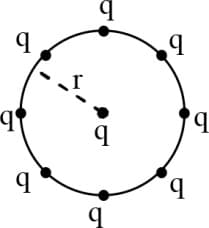Potential Energy of a System of Charges
Potential Energy of a System of Charges: Overview
This topic covers concepts, such as Electrostatic Potential Energy, Electrostatic Potential Energy between Two Point Charges, and Electrostatic Potential Energy of System of Point Charges.
Important Questions on Potential Energy of a System of Charges
Three charges, and , are placed at equal distances, on a straight line. If the potential energy of the system of three charges is zero, then what is the ratio of ?
Three charges, and , are placed at equal distances, on a straight line. If the potential energy of the system of three charges is zero, then what is the ratio of ?
A charged particle is shot towards another charged particle which is fixed, with a speed. It approaches up to the closest distance and then returns. If is shot with speed , the closest distance of approach would be
There is an electric field E in - direction. If the work done on moving a charge of 0.2C through a distance of 2m along a line making an angle with - axis is 4J, then what is the value of E ?
If one charge is fixed and another charge is taken around the other one in a circular path, the work done will be equal to -
Two points and are maintained at the potentials of and , respectively. The work done in moving electrons from to is.
Work done by an external agent to move slowly a charge from rim of a uniformly charged horizontal disc of radius and charge per unit area , to center of this disc is -
The mass of a particle is times that of an electron and the charge is double. The particle is accelerated by . Initially, the particle remained at rest. Then, its final kinetic energy will be
15 joule of work has to be done against an existing electric field to take a charge of from to . Then the potential difference is -
tialThere is cube of edge length . Four point charges each having charge are kept at points , and respectively as shown in the figure. The work done to move a charge of from point to point is

A point charge is surrounded by eight identical charges, at a distance , as shown in the figure. How much work is done by the force of electrostatic repulsion, when the point charge at the centre is removed to infinity?

Potential energy of two equal negative point charges, each, held apart in air, is
Two positive point charges of and are placed apart in the air. The work needed to bring them closer is
An automobile spring stretches upto for a load. The ratio of potential energy stored in this spring when it is compressed by to the potential energy stored in a capacitor at a potential difference of will be,
A ball of mass carrying a charge moves from a point A at potential to a point at zero potential. The change in its KE is
A charge () and another charge () are kept at two points and respectively. Keeping the charge () fixed at , the charge () at is moved to another point such that forms an equilateral triangle of side . The net work done in moving the charge () is
Potential energy of two equal negative point charges each held apart in air is,
